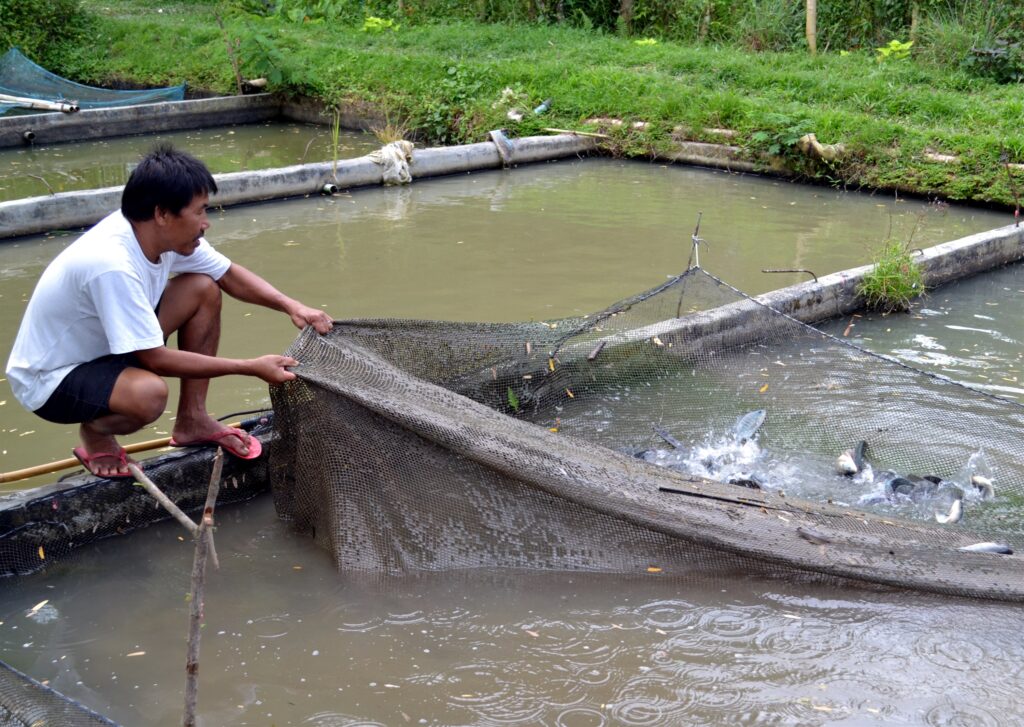Text and Photos by Henrylito D. Tacio
Can tilapia in a pond be all-male?
Yes, it’s possible, according to Dr. Rafael D. Guerrero III, an academician at the National Academy of Science and Technology (NAST).
And it could be accomplished through the so-called “sex reversal technique” or SRT. “SRT is the process by which genetic female tilapia fry are converted into functional males through hormone manipulation,” Dr. Guerrero explains.
Dr. T.K. Yamamoto first developed the technique in Japan in l950 for the Oryzias latipes, an aquarium fish. In l968, two Americans, Howard Clemens and Theophils Inslee published their work on the effectiveness of the technique on the Mozambique tilapia.
In l974, Dr. Guerrero published a paper on the artificial sex reversal of the blue tilapia in the United States, which paved the way for the practical application of the technique.
Today, the Philippines is widely recognized as the “world leader” in tilapia sex reversal technology.
“The method is considered the most practical, effective and economical way to control unwanted reproduction of cultured tilapias in ponds which causes poor growth and harvests due to overpopulation and stunting of fish,” Dr. Guerrero says. “All-male tilapias also result in faster growth, better feed conversion and high survival.”

Dr Rafael D Guerrero III 
Dried tilapia fish
Tilapia has been an important source of food for man, at least since recorded history started. The fish Saint Peter caught in the Sea of Galilee and those with which Jesus Christ fed the multitudes were reportedly tilapia. An Egyptian tomb frieze, dated at 2500 B.C., illustrates the harvest of tilapia and suggests that the fish may have been cultured.
Tilapia was introduced in the Philippines in 1950 when the late Dr. Deogracias Valladolid of the then Bureau of Fisheries (now known as Bureau of Fisheries and Aquatic Resources or BFAR) introduced Mozambique tilapia from Thailand.
Calling it “miracle fish,” the BFAR promoted its nationwide culture in backyard ponds to help the country achieve self-sufficiency in animal protein food. But the Mozambique tilapia’s high reproduction rate resulted in overcrowded ponds and stunted fish, and many Filipinos became disappointed over its performance.
“Tilapias are a prolific lot,” says Dr. Guerrero, who used to be the executive director of the Philippine Council for Aquatic and Marine Research and Development (PCAMRD). “And one of the best methods to solve the overcrowding problem is population control.”
And he was able to do so. But that is getting ahead of the story. According to the Iloilo-based Southeast Asian Fisheries Development Center (SEAFDEC), the female tilapia is smaller (more or less 9 centimeters at age three months) than the male. The male (more or less 11 centimeters at three months) has a more pronounced coloration during the mating period.

Harvesting tilapia 
Tilapia raised in cages
“Tilapias sexually mature in three months,” says SEAFDEC’s M.B. Surtida. “Female tilapias may spawn from 100 to thousands of eggs, depending on their size. Generally, tilapias spawn in shallow portions of lakes, rivers, or ponds. In breeding, the male builds nests on the bottom to attract females. The nests are round and shallow, about 20-25 centimeters wide.
“The male waits for the female partner in these nests. After a brief courtship (to last a few hours), eggs are spawned by the female and fertilized by milt from the male. The female then gathers the fertilized eggs in its mouth to incubate them. The eggs hatch after 3 days. Spawning can occur as often as twice a month during the year if conditions warrant.”
Studies have shown that the male tilapia grows faster and bigger than the female tilapia. The logical choice was to grow all male-tilapias. But how could male tilapias be selected and separated from the females? Was it physically possible to select the fish for stocking in the ponds? It could be done through manual sexing, but the task would be too laborious.
In manual sexing, the male is distinguished from the female tilapia by looking at an organ called the urogenital papilla, which is found near the anus of the fish. There are two openings in the female fish and only one in the male fish.
Manual sexing is cumbersome and time-consuming, not mentioning the openings are not easy to see. Besides, the technique is only 80% accurate because of human error. Another disadvantage is that tilapia can only be “sex fished” when they are three months old. By then, they are almost fully grown.

Dr. Guerrero, who has devoted more than three decades of his life to laboratory and applied science, knew that there was a more practical, effective, and economical way of solving the problem.
He first did an extensive literature quest; he studied the work of other scientists and came across the concept of using sex hormones to reverse the sex of fish—the concept developed by Dr. T.K. Yamamoto, as stated earlier, had not been applied commercially.
Dr. Guerrero became excited at the prospect of applying the concept to Nile tilapia. So, when he went to the Auburn University in Alabama to earn his doctorate in Fisheries Management, he decided to work on the application of the artificial sex reversal concept for his dissertation. After almost two years of research, he was able to show that tilapia fry could be converted to all-male populations when fed with a synthetic male hormone for a certain period during the “sexless” stage.
His dissertation on the Use of Androgens for the Production of all Male Tilapia aurea “more than conclusively proved that the technique could work on a commercial scale.”
A sex-reversed tilapia (SRT) is very virile, has a high sperm count, capable of fertilizing five to ten females. Female tilapias are separated from the rest, with a few males added to do the fertilization of eggs.
How does sex reversal occur? When the fry in the breeding ponds or units are about 7 to 10 days old and about 9 to 11 millimeters long, they are stocked in treatment units. Density of stocking is 250 to 1,000 per square meter. On the first week, they are fed a sex reversal diet containing synthetic male hormones at the rate of two grams per day in four feedings at regular intervals from 8:00 in the morning to 4:00 in the afternoon per 1,000 fries.
For the second week, the feed is increased to 7.5 grams per day. In the third week, the feed rate is 12 grams per day. After the 21-day treatment, the male population ranges from 95-99 percent. The fingerlings are then transferred to regular nursery units or stocked directly in predator-free culture ponds.
But the question is: are those sex-reversed tilapia safe to eat?
The synthetic sex hormone used in sex reversal technology is methyltestosterone, a synthetic form of testosterone. A naturally occurring sex hormone, testosterone, is produced in a man’s testicles. Small amounts of testosterone are also produced in a woman’s ovaries and adrenal system.
“Methyltestosterone is used in men and boys to treat conditions caused by a lack of this hormone, such as delayed puberty or other hormonal imbalances,” notes www.drug.com. “Methyltestosterone is also used in women to treat breast cancer that has spread to other parts of the body.”
According to Dr. Guerrero, the oral treatment with methyltestosterone in tilapia is only for 3-4 weeks during the sexless stage of the fry or what he calls “the stage of sexual differentiation.”
“After withdrawal of the treatment,” he assures, “there are no residuals left in the system of the fish after 92 hours.” He based this statement on some studies being done.
“Since the fry are grown for at least 3-4 months for market and human consumption, it is very safe,” he says. “There can, therefore, be no side effects if there is no synthetic hormone left in the systems of the fish.”
There is also the question of what happens to the metabolites (excreted compounds) of the synthetic hormone, which are eliminated in the environment. Can they affect other organisms and affect people? Dr. Guerrero gives this answer: “Studies have shown that, in the tropics, the high temperature and the effect of sunlight breaks down the metabolites into simpler compounds through biodegradation and photo-oxidation that have no effect on humans.”
Aside from those done in the Philippines, there are also studies conducted in other countries that showed endocrine disruptors from plastics and insecticides in the environment can influence the direction of the sex of fishes and possibly humans who consume them towards femaleness or hermaphroditism and not maleness. “Methyl testosterone, which is for maleness, is therefore not in question,” Dr. Guerrero says.
The use of methyltestosterone for tilapia sex reversal is generally accepted throughout the world except in Europe, which has a strict organic (no synthetics) policy. “So far, since its application more than 30 years ago, there is no negative or harmful effect on humans reported.”

